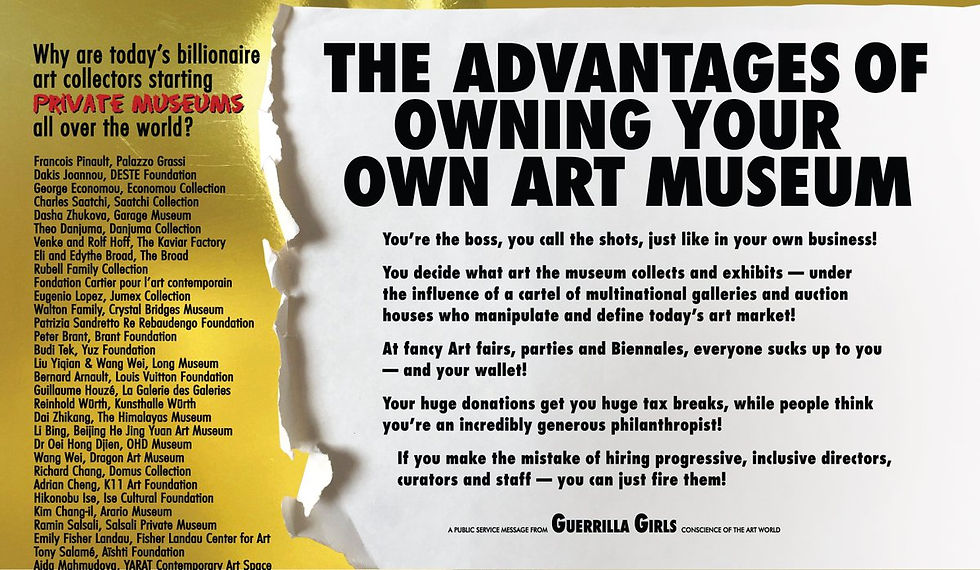Operation "Culture": Presenting the Guerrilla Girls, the Amazons of Art
- by Ralitza Ivanova
- Mar 19, 2017
- 3 min read
My first article is about the Guerrilla Girls simply because their work is one of the main reasons why this blog exists. I was thinking about starting a blog about the arts for a while but wasn’t sure what aspect to focus on exactly. Meanwhile, I was aware that in the field of music, for instance, one could rarely listen to the works of women composers. However, it wasn’t until I saw the Guerrilla Girls' posters revealing the actual statistics behind the ‘sophisticated’ faces of art museums and galleries. If these numbers were the case in art, why would things be different in music or the other art forms?
The Guerrilla Girls are a New York-based collective of anonymous feminist artists who started their activity back in the mid 1980s. They are known for wearing gorilla masks in public and for the use of humorous posters exposing gender and ethnic inequality mainly in art. However, the group also targets “corruption in politics, art, film and popular culture”:


Shocking, isn't it?
The story about the formation of the Guerrilla Girls goes back to 1984 when the MoMA (Museum of Modern Art) organised an exhibition called “An International Survey of Painting and Sculpture”. Among the works of around 170 artists (mainly from North America and Europe!) only 8% were made by women, and almost none by artists of colour. What is more, the curator of the exposition said that any artist who was not selected in his show “should rethink HIS career”. That phrase stroke the girls because it highlighted the assumption that if women and artists of colour were not in the mainstream, then their work was not ‘good enough’ [We shall look at this misconception more extensively in other articles as well because it is a reoccurring theme in many spheres; e.g. check out the article about Sylvia Hinz]. In response to that, the group organised a protest outside the MoMA but that did not seem to impress anyone. So they decided to plaster posters and stickers around New York, exposing the factual statistics that revealed unambiguous gender and racial inequality:
“We realised that the more we laughed and made fun of the art world, the better we felt. And at the time a lot of women and artists of colour were taking their situation personally, not realising that there was a systemic problem. The system did not want us.” (Frida, founder of the Guerrilla Girls)

And she continues in another interview: “Every aesthetic decision has a value behind it, and if all the decisions are made by the same people, then the art will never look like the whole of our culture. And right now the art world is kind of run by billionaire art collectors who buy art that appeal to their values. And we say: Art should look like the rest of our culture. You know, all our voices of our culture are in the history of art. It’s not a history of art. It’s a history of power. “

So why is it so important to include “all our voices of our culture”? Because if we mainly listened to J. S. Bach, Mozart and Beethoven, looked at paintings by Leonardo, Van Gogh and Picasso, etc we would be restricted. It goes without saying that all of the above mentioned artists were geniuses and have left us important cultural heritage. But we want to see the bigger picture. We want to listen to and look at new ideas too. Otherwise how can we evolve culturally?
Of course society is slow to change. And of course beating the big money and ‘not giving up’ is easier said than done. But as Käthe, another Guerrilla Girl puts it: “One thing that we’ve learned is that if you do one thing – put it out there. If it works, you do another. And if it DOESN’T you do another. This is true for all of us. You can’t expect one thing to make a difference. But if you keep doing it, and keep chipping away over time you can make a difference.”
Sources:
http://www.guerrillagirls.com
Guerrilla Girls interviewed by Stephen Colbert "Guerrilla Girls Talk History of Art vs. History of Power", video
The Art of Complaining - The Guerrilla Girls at TATE Modern, London | The Art Assignment, video
The Guerrilla Girls, Going and Going | The New York Times, video
Guerrilla Girls - images and projects 1985 - 2016, video




Comments